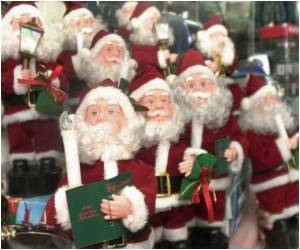Accompanied by hooded penitents, tens of thousands of people Friday attended Easter processions in Seville, where wooden sculptures of religious scenes are carried through the streets.
Accompanied by Accompanied by hooded penitents, tens of thousands of people Friday attended Easter processions in Seville, where wooden sculptures of religious scenes are carried through the streets., tens of thousands of people Friday attended Easter processions in Seville, where wooden sculptures of religious scenes are carried through the streets.//
The six processions, organised by religious brotherhoods and broadcast live on television across the country, began just after midnight and lasted until 2 pm (1200 GMT) with the southern Spanish city's metro system kept open all night to help move the crowds.They follow a designated route from the floats' home churches to Seville's main cathedral in the historic centre of Spain's fourth largest city.
While processions are held in other Spanish cities to mark the day when Roman Catholics believe Jesus Christ was put to death by crucifixion 2,000 years ago, the ones held in Seville are among the biggest and most solemn.
"There is a sensation that you are being transported to another moment in history, it is unique, this is something that has been done for six or seven centuries and continues almost unchanged," said 36-year-old Carlos Garcia who has taken part in the processions as a penitent since he was six.
"It is not about religion, it is pure tradition," he told AFP.
The floats, known as pasos, depict Jesus bearing the cross or the Virgin Mary showing grief for the torture and killing of her son. Many of the life-sized wooden figures date back centuries and are considered masterpieces.
Advertisement
"I see them as precious artistic expressions," said Agripina Saldana, whose husband Manuel was one of the "costaleros" who carried a float depicting Jesus through the streets of Seville.
Advertisement
Its appearance causes many in the crowd to weep, applaud or perform "saetas", flmaneco verses sung at Holy Week processions.
Others throw petals from carnations or roses on the float from the balconies of their apartments as the float passes by.
Manuel Saldana, 38, said "costaleros" work out all year to be fit enough to carry the floats. The one he carried through the streets with 47 others weighed 2,500 kilos (5,500 pounds).
Saldana said a mixture of "devotion" and "a feeling you can't explain" have led him to by a "costalero" for the past eight years.
His 71-year-old mother Maria said she feels "great emotion" during the procession, especially since her son is a "Costalero".
"I think it is because of the faith that I have in Christ and in the La Macarena. We see each other and we are moved, we hug everyone," she said.
Manolo Bernardo, 36, who has marched as a penitent in the Good Friday processions for the past 24 years, said he was "beat" each time after marching for hours.
"Every year when I would reach the Cathedral I would say to myself: 'It's over, I am not doing this again' and you think 'why do I need to beat myself up this way?'. But then there is something that makes you decide to do it again, that gives you the desire to participate," he said.
Source-AFP
TRI









